Interview with Peggy Wagoner
This interview is part of a series which highlights the work of various individuals and organizations within the Kernza® network. Through these interviews, we aim to share and celebrate that there is a large and ever-changing ecosystem that moves Kernza® perennial grain forward. To learn more about the Kernza® network, visit our directory.
Can you tell me about your work with Intermediate wheatgrass and how you became involved with it at the Rodale Institute?
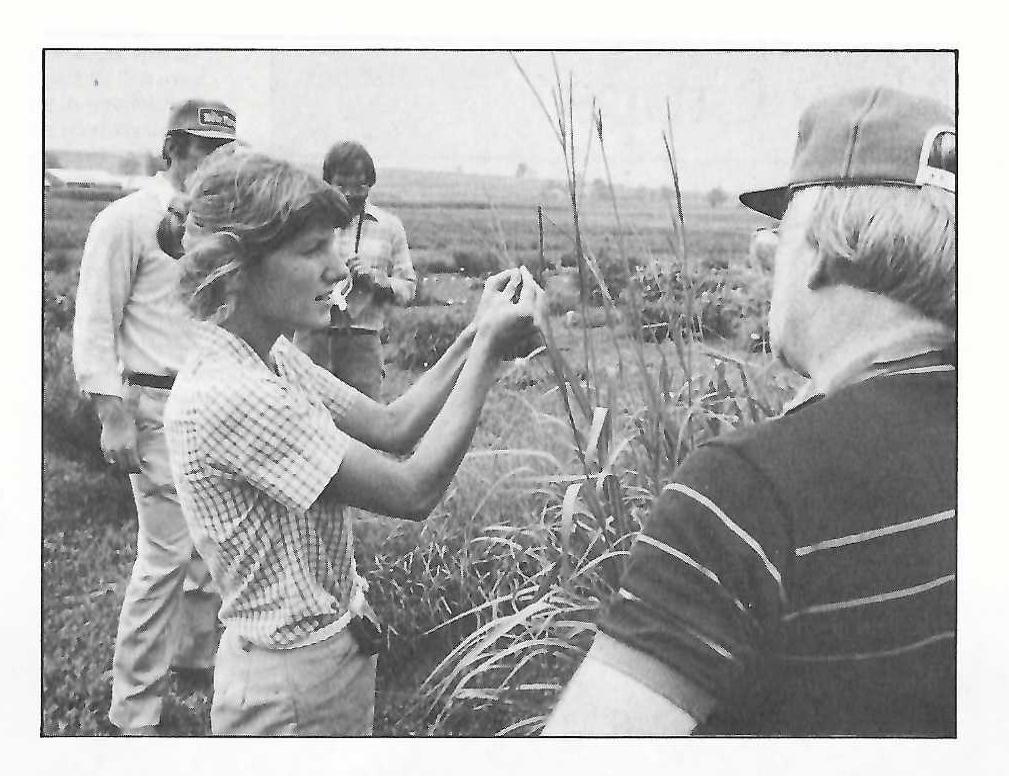
I worked at the Rodale Research Center (now Rodale Institute), an organic agricultural research center in Pennsylvania, starting in 1978. However, my background was in biology and ecology, not agriculture. After working at Rodale for over a year, I had the opportunity to take courses in agriculture at Washington State University for two academic years, then returned to Rodale, in the New Crops department. At the time, we were working on developing grain amaranth as a new crop for the US. I participated in germplasm evaluation and production trials. That was my first exposure to the complexities of introducing a new crop into the food system.
Robert Rodale, the head of Rodale Press and Rodale Research Center, was friends with Wes Jackson. He was very interested in Wes’s ideas about perennial polyculture—an agriculture based on perennial crops as opposed to annual crops. In the early 1980s, there was a lot of concern about soil erosion. Robert Rodale felt that it would be important for the Rodale Research Center to begin a program to work on perennial grain development as a means of addressing soil erosion and other problems associated with annual agriculture. Since I was in the New Crops department, they said, “Peggy, why don’t you do it?” I was thrilled! The ideas were based on natural ecosystems so it made perfect sense to me.
Because your background was in ecology?
Exactly, and I always loved nature from the time I was a kid. My passion is for working to find solutions to the environmental degradation caused by agriculture. Agriculture impacts so much of our landscape. If we hope to improve the environment (air, water, biodiversity, human and ecosystem health including justice and equity), we have got to change the way much of agriculture is conducted. This effort to develop perennial grains and ultimately perennial polycultures fits perfectly with my strong belief that we have to complement and enhance natural ecosystems, not destroy them, the way unfortunately much of agriculture is currently (I mean for the last 10,000 years) conducted.
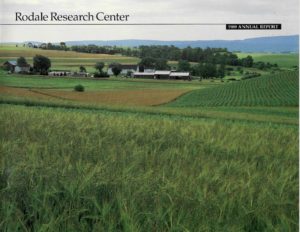
Initially for our perennial grain research program at Rodale, I was essentially a one woman show until my valuable assistant, Anne Schauer, joined the project in 1984. It was up to me to decide how we approached the project. In the fall of 1982, I spent a lot of time talking to Wes for a deeper understanding of his concept and for suggestions of how to proceed. Wes suggested planting a lot of different species in an herbary to get ideas of which species are adaptable in our area and which species may show potential for development. That winter, I looked through a variety of seed catalogs and ordered all kinds of herbaceous perennial seeds including grasses, legumes, sunflowers and more. In spring, 1983, I planted these seeds in the greenhouse and transplanted them out into an herbary in the early summer.
Because of my work with amaranth, I understood the many facets and the daunting task of developing a new grain crop: the development of varieties that yield a harvestable, flavorful crop that can compete with well-established existing crops; the ability to break into established markets and be highly desired by consumers, all timed perfectly to match supply and demand.
Initially, we were looking for species that exhibited plant structures that lent themselves to mechanical harvest to produce a potentially useful seed crop. Ideally, we wanted to find species that produced seeds above the leafy portion of the plant on strong stalks that would withstand lodging, had relatively synchronous seed maturity for a yearly harvest, and relatively large seeds that are fairly easily threshed from the hulls but that would not shatter the instant they mature. In addition, the grain/seeds that were produced had to be edible, with good flavor.
Based on these criteria, we chose intermediate wheatgrass (IWG). We also did food use tests on the seeds of several different perennial grasses including IWG. There were many things that were pointing towards intermediate wheatgrass as a species worthy of pursuing. It had a mild taste, the performance in the field was good, and we were able to get quantities of seed. Because it was already grown as a forage grass, there was already some knowledge about seed production techniques from the seed industry that produced seeds for farmers and ranchers to plant. Also, because IWG was a relative of wheat, we could be fairly confident that it did not have any major anti-nutritive properties that may make it dangerous to consume.
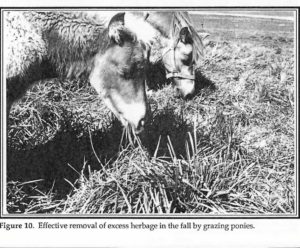
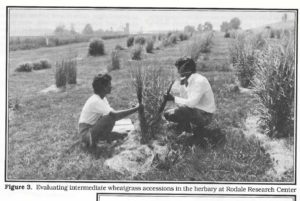
What was the attitude towards perennial agriculture when you were doing this research? Was the interest in perennial polyculture systems shared by your colleagues, or farmers in the area?
I was so happy that the research directors at RRC gave the project to me but in hindsight, I’m wondering if they thought “she’s probably only going to be around for a couple years to work on this anyway” at which point they could have let the program fade. That’s just my speculation though. I do know that a couple of years into the project, the people that led the research center were starting to feel like this program was too “pie in the sky”, that maybe Rodale shouldn’t be putting efforts into it. I remember I wrote a memo, a passionate memo, that defended it and said that this project is exactly the kind of thing that Rodale should be doing. At that point in the research, I was able to save the program.
I wish you still had that memo. I would have loved to read it!
I was able to keep the program going through the 1980s. Then, the decision was made to separate Rodale Research Center from Rodale Press, which meant that we had to generate our own funds. Around the same time, Robert Rodale was killed in an auto accident in Russia in 1990. So, any support I might have had was gone.
In 1990, the research directors wanted our perennial grain project to be scaled way back. Anne was taken off the project entirely and I was only allowed to devote about 10% of my time. A portion of the herbary and a few grain production plots were maintained for a few more years since they were perennial and didn’t require a lot of effort to continue. Fortunately, we had already started a collaborative breeding program with the Natural Resources Conservation Service, at the Big Flats Plant Materials Center in New York. Also, for a few years, we were able to continue evaluation of some of the newer intermediate wheatgrass accessions that we had recently selected from John Berdahl’s forage breeding lines at the USDA Northern Great Plains Research Center in Mandan, North Dakota. The research directors recognized the value of collaborations with NRCS and the generosity of USDA to share IWG breeding lines.
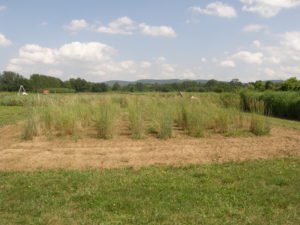
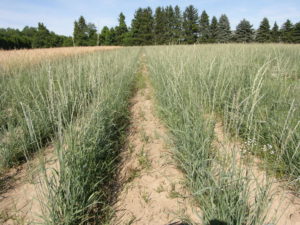
The main focus of perennial grain research at Rodale Institute in the 1990’s was our collaboration with Martin van der Grinten at NRCS, Big Flats PMC. Using only classical plant breeding techniques, we completed 2 cycles of a Recurrent Phenotypic Selection breeding program to develop higher grain yielding lines of IWG. The other projects I worked on during the 90’s were interesting (comparing organic and conventional production methods) but they were all using well established annual grain crops (corn, soybeans, wheat) My heart was really committed to perennial polycultures.
In your wildest dreams, what did you envision for intermediate wheatgrass? How did you imagine it might look on the landscape in the future?
I was just kind of plugging away. I knew that the breeding was going to be the thing that would help at least increase grain yields. There’s a certain amount of production and management techniques that can help but the greatest gains come from breeding. I was happy to be a part of that and to collaborate with Martin van der Grinten at Big Flats Plant Material Center so that I didn’t feel alone in it. I knew that it would be decades before truly economically viable varieties would be available for farmers to grow and for consumers to enjoy. Ultimately, (probably when I’m long gone) I hope for herbaceous perennial crops grown in manageable polycultures that not only provide sustenance to humans, but that provide healthy habitats for wildlife to thrive as well.
Can you talk a little more about the timeline of this work?
It was a challenge. In the 1990’s we were selling seeds/grain in the Rodale bookstore and sharing recipe ideas. There were various attempts to make it more interesting. For example, I came up with the name Wild Triga. For the record, I think the name Kernza® is much better than Wild Triga.
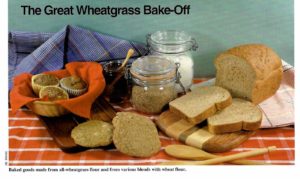
Rodale wanted to promote it as if it was ready, but it wasn’t. It makes sense; they wanted to have something to show for their work. I didn’t agree with the early promotion but I had to go along with it in order to keep in the good graces of management and keep the project going as much as possible. That’s why The Land Institute is so amazing, because you’ve stuck with it for so long. It takes somebody like Wes Jackson—someone with an incredible passion who is good at inspiring people and getting them involved—to help shepherd this massive undertaking and pass it along to younger generations to continue the pursuit of agriculture based on productive perennial polycultures.